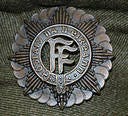IRISH AIR POLICING FIGHTER SQUADRON SHOULD BE BASED AT SHANNON AIRPORT
Brig Gen Ger Aherne (Ret’d) and Lt Col Jim Lynott (Air Corps Pilot Ret’d)
Obligations in International Customary Law on states who declare themselves sovereign are little ventilated in Ireland. National assets capable of securing our territorial land, sea and air borders are a sovereign state obligation. Ireland does not possess such assets. By OECD metrics, Ireland is a medium sized country, not a small country as regularly stated. Ireland is one of the richest economies in Europe and the EU.
Our EU/ international partners are alarmed at Ireland’s national security indifference. This directly threatens their national security, most especially Europe’s. Historically, Ireland believed its geography on the periphery of Europe was a defence against malign attack. Not anymore. Ireland’s positioning controls the western air and sea approaches to Europe, avenues of approach for potential malign air and sea belligerents. Many undersea cables connecting the world pass under Irish waters.
85% of all transatlantic flights enter and pay a navigation charge to transit Ireland’s airspace. Yet, we have no means of protecting our national air sovereignty. There are three basic requirements to achieve this; primary radar military specification detection; air intercept capability; communications capability for high level decision making if a rogue aircraft is identified and confirmed in Irish airspace.
Ireland’s directly controlled airspace extends deep into the Atlantic, an area approximately six times larger than our sovereign land mass. Ireland’s airspace of interest reaches even further, extending to mid-Atlantic longitudes. Some 1.2 million flights pass through Irish airspace on an annual basis representing, approximately 80% of trans-Atlantic flights.
On Europe’s western flank, Norway, United Kingdom, France, Spain, Portugal and Iceland, possess sizeable air policing capabilities with primary military radar and Quick Reaction Alert (QRA) aircraft. Ireland is the only country on Europe’s West Atlantic frontier not possessing primary military radar and QRA capabilities. This is a worrying gap in Western European airspace monitoring and air security.
Air policing is a peace-time capability. It involves the monitoring of airspace; identification of aerial threats; the interception/ escorting out of Irish airspace of rogue or unidentified aircraft. Ireland does not possess a meaningful air policing capability and must develop one rapidly. For Ireland to acquire that capability would entail an initial capital cost €350m to purchase the aircraft and an annual crewing and maintenance cost of €20m.
Typically, air policing consists of four key elements: Intercept aircraft, normally with supersonic capability; Rapid Response, typically achieved with Quick Reaction Aircraft (QRA) (24/7) capability; Situational Awareness, Primary surveillance radar to monitor and identify targets and control ‘friendly’ aircraft for intercept; Command/ Control, Systems Support.
Ireland’s current air policing capability is ‘token’. Air Corps’ Pilatus PC9M aircraft are capable of low altitude low speed air intercept only. Ireland has no effective primary radar with no capability to monitor its sovereign airspace. European countries of Ireland’s size, Finland, Norway, Denmark, Austria possess comprehensive ‘full’ air defence with large fleets of 4th/ 5th Generation fighter aircraft.
Any Irish air policing aircraft should be stationed along our west coast to launch into the most likely approach paths of rogue or unidentified aircraft, namely from the west and northwest approaches. This makes Shannon Airport the best operationally appropriate location to station Irish intercept aircraft.
Stationing sovereign air assets at Shannon would be a major confidence building message for our EU and international allies. It would increase the use and prestige of Shannon Airport, be a multiplier of military employment to that region with its ripple effect economic benefits. Crewing/ staffing air policing at Shannon would require 200 Air Corps personnel of mixed qualifications/ skillsets. When families are added to that workforce, it could reach as many as 1,000 people, consistent with the states policy of supporting regional development and employment in an area long associated with aviation.
The appropriate aircraft required for this role in Ireland would be what’s termed a Light Combat Aircraft. These are advanced supersonic jet training aircraft converted to combat use and capable of high-altitude, high-speed intercept. The two most suitable aircraft types would be the Korean FA-50 or Swedish Saab Gripen. The FA-50 would be more economical to purchase and maintain, is more recently developed with purpose designed avionics and weapons systems.
In conclusion, this ‘realistic’ capability would provide credible peace-time control of Irish airspace, coupled with a scalable capability which could be expanded, if required, to full air defence. For an initial outlay of €350m, and an annual operational cost of €20m, its long overdue Ireland having this sovereign capability. Shannon Airport is strategically and operationally ideal for this task.
